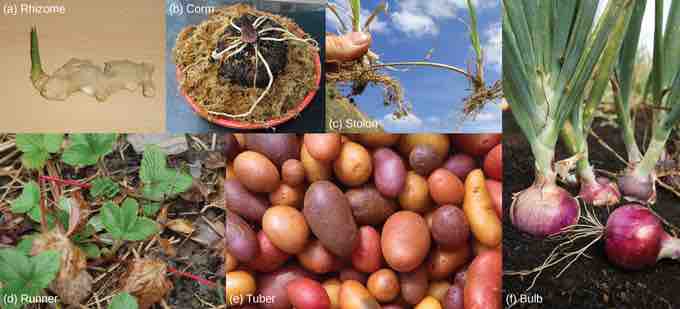Stem Modifications
Some plant species have modified stems that are especially suited to a particular habitat and environment. A rhizome is a modified stem that grows horizontally underground; it has nodes and internodes. Vertical shoots may arise from the buds on the rhizome of some plants, such as ginger and ferns. Corms are similar to rhizomes, except they are more rounded and fleshy (such as in gladiolus). Corms contain stored food that enables some plants to survive the winter. Stolons are stems that run almost parallel to the ground, or just below the surface, and can give rise to new plants at the nodes. Runners are a type of stolon that runs above the ground and produces new clone plants at nodes at varying intervals: strawberries are an example. Tubers are modified stems that may store starch, as seen in the potato. Tubers arise as swollen ends of stolons, and contain many adventitious or unusual buds (familiar to us as the "eyes" on potatoes). A bulb, which functions as an underground storage unit, is a modification of a stem that has the appearance of enlarged fleshy leaves emerging from the stem or surrounding the base of the stem, as seen in the iris .

Stem modifications
Stem modifications enable plants to thrive in a variety of environments. Shown are (a) ginger (Zingiber officinale) rhizomes, (b) a carrion flower (Amorphophallus titanum) corm (c) Rhodes grass (Chloris gayana) stolons, (d) strawberry (Fragaria ananassa) runners, (e) potato (Solanum tuberosum) tubers, and (f) red onion (Allium) bulbs.
Modifications to the aerial stems, vegetative buds, and floral buds of plants perform functions such as climbing, protection, and synthesis of food vegetative propagation . Aerial modifications of stems include the following:

Aerial modifications of stems
Found in southeastern United States, (a) buckwheat vine (Brunnichia ovata) is a weedy plant that climbs with the aid of tendrils. This one is shown climbing up a wooden stake. (b) Thorns are modified branches.
- Tendrils are slender, twining strands that enable a plant (like the buckwheat vine) to seek support by climbing on other surfaces. These may develop from either the axillary bud or the terminal bud of the stem.
- Thorns are modified branches appearing as hard, woody, sharp outgrowths that protect the plant; common examples include roses, osage orange, and devil's walking stick.
- Bulbils are axillary buds that have become fleshy and rounded due to storage of food. They become detached from the plant, fall on ground and develop into a new plant.
- Cladodes are green branches of limited growth (usually one internode long) which have taken up the functions of photosynthesis.